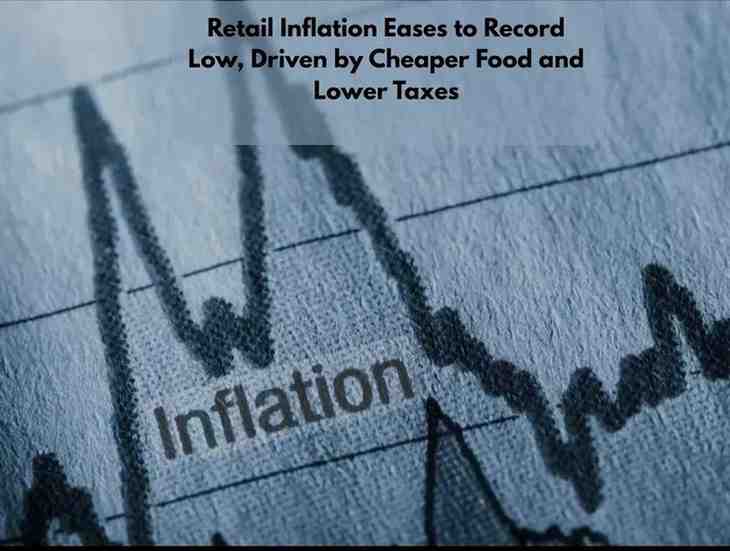India Records Historic Low Retail Inflation in October — CPI Falls to Just 0.25%

India has reached a landmark moment in its economic journey. Retail inflation — the price rise felt by everyday consumers — has dropped to its lowest level ever recorded. Official data released on November 12 by the Ministry of Statistics and Programme Implementation (MoSPI) reveals that the Consumer Price Index (CPI) for October stood at a mere 0.25%, marking an extraordinary slowdown in inflation driven largely by cheaper food prices, a stable supply chain, and recent tax reforms.
By Asmita Pant | Updated: November 12, 2025 | 6 Min Read
This figure represents the lowest year-on-year inflation rate since India began tracking prices through the current CPI system. Analysts and economists had widely predicted such a cooling trend — a CNBC-TV18 poll had forecast exactly the same figure, reflecting broad market agreement that inflationary pressures were easing fast.
What Exactly Is CPI and Why It Matters
The Consumer Price Index (CPI) is one of India’s most critical indicators of price stability. It measures the average change in the cost of a basket of goods and services that households typically purchase — from groceries and rent to transportation, healthcare, and clothing.
A rising CPI indicates that prices are increasing, meaning consumers are paying more for the same goods and services — a sign of inflation. Conversely, a fall in CPI shows that prices are stabilizing or even declining, often referred to as deflation.
This measure guides important economic decisions, from RBI’s interest rate policy to how much consumers can spend without eroding their purchasing power.
Food Prices Take the Spotlight — Key Driver of the Decline
The October inflation figure dropped a sharp 119 basis points from September’s 1.44%, a steep month-to-month fall that underscores just how significantly food prices have cooled.
Food inflation alone stood at –5.02% in October, compared with –2.33% in September — marking the fifth consecutive month of food deflation.
Breaking it down:
- Rural food inflation: –4.85%
- Urban food inflation: –5.18%
This downward movement was largely driven by falling prices of vegetables, fruits, cereals, edible oils, and eggs. Even non-food categories like footwear and transportation showed notable declines due to reduced fuel costs and lower GST incidence.
For millions of households, this meant lower grocery bills and some much-needed financial breathing space ahead of the festive season.
Why Are Prices Dropping So Fast?
According to the Ministry’s analysis, several intertwined factors have contributed to this unprecedented drop in retail inflation:
- GST rate cuts implemented earlier this year had their full effect during October.
- A favorable base effect, meaning prices were already high last year, making the current year’s figures look relatively lower.
- Improved agricultural output and stable fuel prices, ensuring smoother supply chains.
Essentially, a combination of better crop yields, proactive fiscal policy, and global commodity stability helped bring down overall inflation.
Regional Picture: A Tale of Two Indias
Interestingly, the cooling trend wasn’t uniform across all states. Data shows that:
- Kerala, Punjab, and Karnataka continued to see mild price increases.
- Uttar Pradesh, Madhya Pradesh, and Telangana entered deeper deflation territory, largely due to significant falls in food and transport prices.
This mixed picture suggests that while some states are still dealing with minor inflationary pressures, others are firmly in a zone of price correction — a rare phenomenon in India’s diverse economy.
What the Experts Are Saying
Economists have largely welcomed the latest CPI data, calling it a positive development for both policymakers and consumers.
Suvodeep Rakshit, Chief Economist at Kotak Institutional Equities, believes the trend signals overall economic health:
“This level of moderation is encouraging. We continue to project an annual average inflation of around 2.1% for FY26. Inflation may edge up gradually, reaching about 3.5% by March, but food prices are expected to stay stable thanks to normal monsoon conditions.”
Kanika Pasricha, Chief Economic Advisor at Union Bank of India, agrees that inflation will remain below the Reserve Bank of India’s (RBI) target for some time:
“Our outlook suggests inflation around 0.5% this quarter versus RBI’s projection of 1.8%. It might rise to 2–2.5% next quarter, but we don’t expect any sharp spikes before mid-2026.”
Meanwhile, Devang Shah, Head of Fixed Income at Axis AMC, believes this scenario could prompt a monetary policy shift:
“Given the soft inflation numbers, there’s room for the RBI to reduce rates — possibly by 25 basis points in December. Such a move would align with market expectations and could further lower bond yields.”
How This Impacts Everyday Indians
For the average household, this historic low inflation translates to tangible benefits:
- Groceries and essentials: Prices of everyday items have stabilized or even fallen, offering more room in family budgets.
- Transport and fuel: Stable oil prices mean lower commuting costs.
- Loans and EMIs: If the RBI moves toward a rate cut, borrowing costs for home, auto, and business loans may decrease.
- Investments: Bond markets could see a rally as yields adjust downward, while equity markets may react positively to improved economic stability.
Businesses, too, stand to gain as lower inflation can reduce input costs and strengthen consumer purchasing power.
The Broader Economic Perspective
India’s record-low CPI for October isn’t merely a statistical record — it represents a deeper shift in the country’s economic trajectory. The data signals that fiscal prudence, policy coordination, and supply-side management are yielding visible results.
While experts caution that prices may start to inch up again in coming months, especially with seasonal demand and international oil market fluctuations, October 2025 will likely be remembered as a turning point. It reflects how India’s economy is maturing — balancing growth with price stability and reinforcing consumer trust in the system.
Looking Ahead
As the nation enters FY26, the challenge will be to maintain this momentum without triggering deflationary risks. Policymakers are expected to monitor food supply, rural demand, and international commodity trends closely.
If stability continues, India could enjoy a rare period of low inflation with sustained growth, a combination that most emerging economies struggle to achieve.



